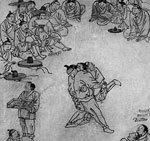Taekwondo 태권도Taekwondo Preschool
Korean martial arts are military practices and methods which have their place in the history of Korea but have been adapted for use by both military and non-military personnel as a method of personal growth or recreation.
About Subak 수박
Subak is either a specific or generic ancient Korean martial art. Historically this term may have specified the old Korean martial art of taekkyeon, but it is unsure.
History
Originally, Korea was divided into three kingdoms: Silla in the southeastern part of the country, Goguryeo (Koguryo) in the northern part, and Baekje located west of Silla.
In the 18th century, even the king practiced Subak, as the text Dongsa-gangmok (동사강목) from this time suggests:
The king himself made a Subak tournament
(왕이 직접 수박희를 하였다)
It was a style that utilizes hand strikes, kicks, jointlocks, and throws. The mountainous terrain of Goguryeo may have made its people's legs strong.
The word Seonbae (also romanized as sonbae, literally: "elders" - 先輩/선배) is sometimes translated to mean "a man of virtue who never retreats from a fight" because it was the term used to signify a member of Koguryo's warrior corps. Members of the Seonbae lived in groups and learned archery, Gakju (ancestor of ssireum) and Subak (ancestor of taekkyon), history, literature, and other liberal arts. Although they were constantly training in combat, during peace time they helped construct roads and fortresses, assisted after natural disasters and so on.

In the year 400, in an attempt to dominate the entire southern portion of the country, Baekje invaded Silla. King Gwanggaeto the Great of Goguryeo is said by some accounts to have sent 50,000 Seonbae troops to Silla's aid. Later he would attempt to dictate Silla's internal affairs because of this assistance.
It was around this time that the people of Silla formed an elite officers' corps called Hwarang. The Hwarang may have utilized techniques from Subak in addition to training in spear, bow, sword, halberd and various forms of hand and foot fighting.
Split
Subak took a heavy blow during the Joseon period, which was founded on the ideology of Confucianism, stressing literary art instead of martial art. Subak was only allowed to be practiced in competitions called subakhui. After three consecutively successful subakhui bouts, only then could the winner become employed as a soldier.
Perhaps during the beginning of the Joseon dynasty Subak became Taekkyeon. Yusul means "soft" and Taekkyeon has "yusul" movements. Some authors, such as Robert W. Young, think that Subak became Taekkyeon, the same martial art just renamed. Yusul [유술/柔術] is written with the same Hanja as Jujutsu, and since 柔 means "soft/pliable/yielding" any yusul techniques would naturally "redirect" an opponent's force rather than meet it head on. Kwonsul [권술/拳術], is the contrasting term and although it literally means "fist technique" it no doubt included strikes made with the feet as well as the hands. Taekkyeon [태껸] was a term regarded more in line with a game or idle training methodology, whereas kwonsul [권술/拳術] or kwonbeop [권법/拳法] was the terminology usually associated with hand-to-hand fighting techniques. A similar argument could be made regarding ssireum [씨름] (a game) and japgi [잡기] (grappling skills).
When you reach senior belt you are expected to guide the junior belts when they are beginning Taekwondo such as showing by example. To advance from one rank to the next, students typically complete promotion tests in which they demonstrate their proficiency in the various aspects of the art before a panel of judges or their teacher. View Taekwondo belt levels »
RESOURCES
This article uses material from the Wikipedia article "Subak", which is released under the Creative Commons Attribution-Share-Alike License 3.0.


















